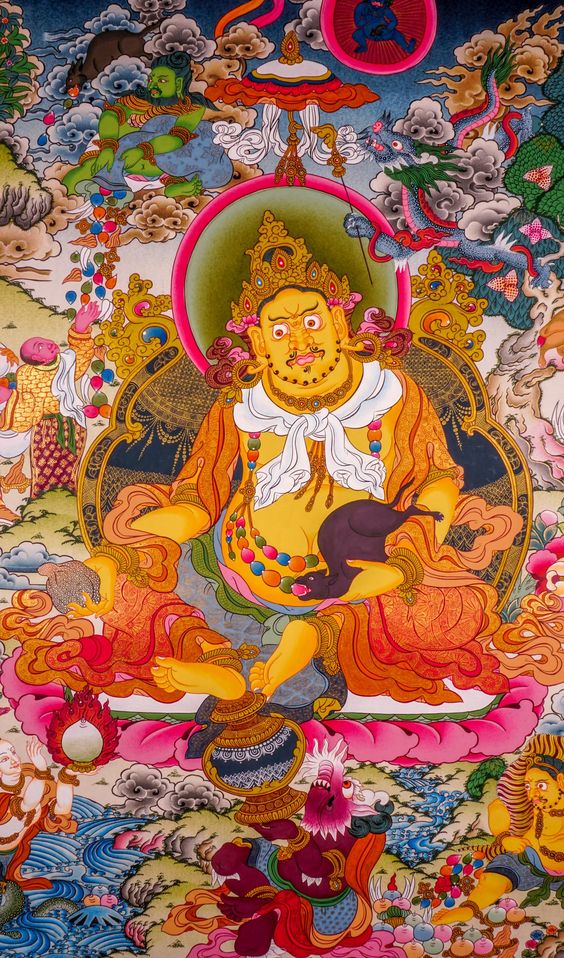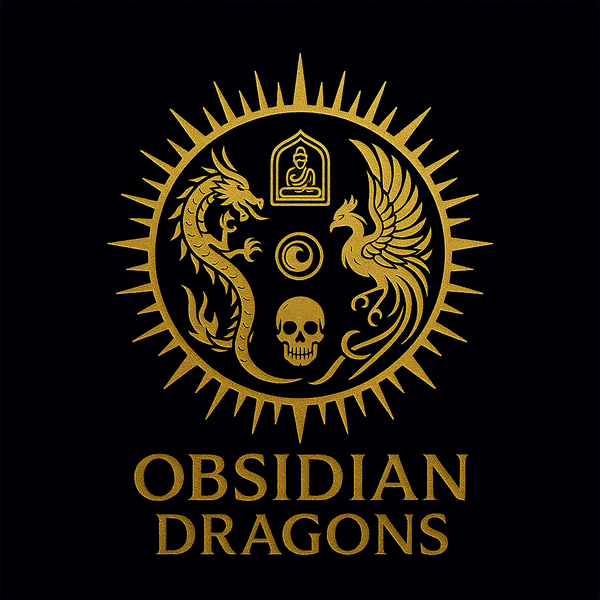
Jambhala, Tibetan Wealth Deity
Share
Jambhala (also known as Dzambhala, Dzambala, Zambala or Jambala) is the God of Wealth, Protector of the North East, and appropriately a member of the Jewel Family (Ratna) whose Dhyani Buddha is Ratnasambhava.
In Hindu mythology he is known as Kubera. Jambhala is also considered an emanation of Avalokitesvara or Chenrezig, Bodhisattva of Compassion.
He is the protector of all lineages and of all sentient beings from all sickness and difficulties. Jambhala is a Bodhisattva of material and spiritual wealth as well as many other things including granting financial stability. "Because in this world there are all kinds of wrathful and negative emotions or evil spirits, and sometimes they harm you and other sentient beings, Dzambhala must assume such a wrathful and powerful form to protect us from such harmful spirits and negative karma. In particular, Dzambhala helps us to minimize or lessen all misfortunes and obstacles and helps us to increase all good fortune and happiness. »
Dzam means " assembly " Or " divinity”. " gold or wealth “, Bhah, which means “t ohonor ", is the meaning of the word " there » . Dzambhala means "precious golden deity who gathers or distributes spirituality or Dharma with material stability or fulfillment to our circumstances. "
The Buddhist deity of wealth Jambhala has several manifestations; there are at least twelve in the Sarma traditions alone, not counting the numerous figures of the " Revealed Treasure " tradition found in the Nyingma school of Tibetan Buddhism. Because there are four dakinis in the entourage, the white Jambhala is considered a five-deity Jambhala in the Jowo Atisha tradition. 'other forms of Jambhala with a five- figure composition if a thorough investigation is made. Jambhala meditation.
1. Yellow Dzambhala:

It is believed that the best known and most powerful of the gods of wealth is the yellow Dzambhala. He is the emanation of Buddha Ratnasambhava. In all six areas, it can end poverty while enhancing virtues, longevity, and wisdom. He is usually depicted seated on a moon-disc lotus with a semi-wrathful expression decorated with gold. Yellow Jambhala is seen with silk clothes, a crown, gold and exquisite jewelry. With a mongoose in his left hand and a Bijapuraka (lemon) fruit in his right, he sits majestically on a throne. The mongoose, which represents Jambhala's triumph over the Nagas, continually spits priceless gems and riches.
Mantra: Om Jambhala Jalendraye Svaha
2. Black Dzambhala:

The Hindu deity of prosperity, Kubera, is believed to have originated in India as the Black Jambhala. The black Jambhala monument represents the eradication of human greed and ego. Hailing from ancient India, he appeared from the waters of the river and imparted the ability to create prosperity to a monarch whose country was suffering from severe financial difficulties at the time. Jambhala's body is painted black. He is seen standing above a human body as a metaphor for taming human egos and eradicating human greed. His left hand clutches a mongoose named Nehulay that shoots diamonds from its mouth, while his right hand holds a jar of gems. Additionally, Black Jambhala has a snake necklace around his neck. As such, Black Dzambhala attempts to relieve the urges created by extreme poverty.
Mantra: Om Jambhala Jalendraye Bashu Dharini Swaha
3. Red Dzambhala:

The Red Dzambhala is usually depicted with his consort seated on his lap as he meditates, the celestial mother of wealth who is in charge of wealth in the human realm. In ancient times, royalty and rulers were the primary practitioners of this deity in ancient times. His method can attract people, money and fame, which makes it more suitable for those in high positions or those who wish to pray for high positions. We will have a lot of wealth, we will get the respect of others and we will receive their support. Vajrasattva manifests as Red Jambala. He has four arms and two faces, and his left hand holds a treasure mongoose.
Mantra: Om Jambhala Jalendraye Dhanam Medehi Hrih Dakini Jambhala Sambhara Svaha
4. White Dzambhala:

Jambhala, also known as Dzambhala Gapee in Tibetan, is the compassionate embodiment of Bodhisattva Chenrezig (Guan Yin). He is able to eradicate poverty and disease-related suffering, cleanse negative karma and karmic obstacles, prevent disease and calamity, and advance Bodhicitta thought. Jambhala, the embodiment of Avalokitesvara Bodhisattva, emerged from his right eye. He is seen seated on a snow lion, but other painters have him on a dragon, and his left hand holds a mongoose that spits priceless jewelry and accessories. The White Jambhala has a body tint of white. Additionally, he wielded a golden sword in his right hand and a banner of wealth in his left.
Mantra: Om Padma Krodha Arya Jambhala Hridaya Hum Phat
5. Green Dzambhala :

the best known of the five Jambhalas, has a portrait of Buddha Amoghasiddhi, who is seen holding a mongoose in his left hand and a kapala in his right while standing on a corpse. In the majority of representations, he is seen holding the hand of his companion and a jewelry-producing mongoose to his left. Green Jambhala's body has a blue-green tint. He is lying in the Vajra posture, with Dakini in front of him. Her right foot is on top of a snail and a lotus flower, and her right leg is rolled up. Her right hand holds Norbu, while her left holds a mongoose named Nehulay who has spewed gems from her mouth. The Dakini has a lotus flower in her palm.
Mantra: Om Karma Jambhala Ah Swaha
Tibetan folklore explains how the Jambhala Gods of Wealth appeared. It is claimed that Lama Atisha, a respected high lama, was alone when he came across a person who was starving and about to die. Lama Atisha offered the older adult some meat from his own body after searching in vain for the area for food. The person refused the meat from the Lama. The Lama sat next to the dying person as he was depressed and did not know how to help the dying person. At that moment, a blinding and dazzling white light emerged, and the thousand-armed Avalokiteshvara Chenrezig, the Buddha of Compassion, came before Atisha. The Buddha assured Lama Atisha that he would take the form of Jambhala, the god of wealth, and ensure that the poor no longer know suffering.
